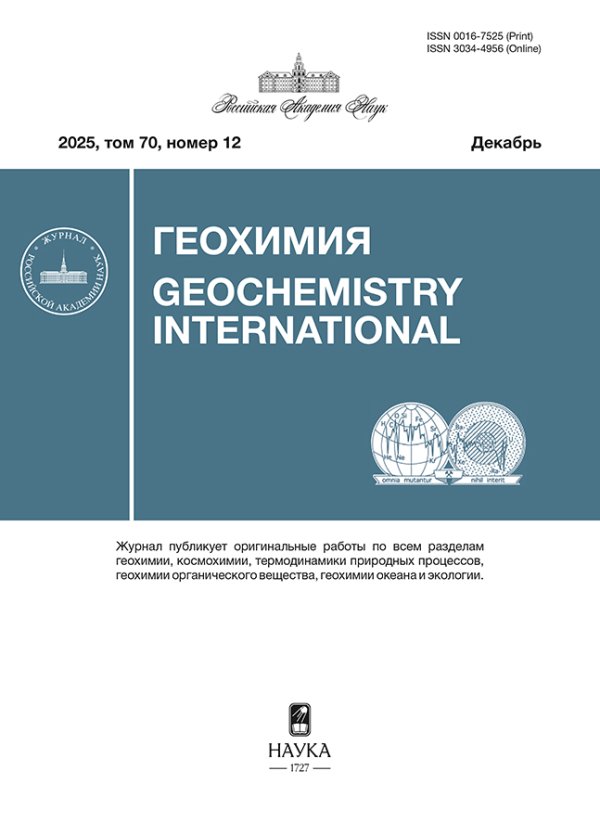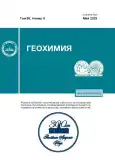Quartz-Hosted Fluid Inclusions in Commercial Ores of Various Type at the Verninskoe Gold Deposit, Bodaibo District, Russia
- Authors: Kotov A.A.1, Prokofiev V.Y.1, Volkov A.V.1, Zlobina T.M.1, Murashov K.Y.1
-
Affiliations:
- Institute of Geology of Ore Deposits, Petrography, Mineralogy, and Geochemistry (IGEM), Russian Academy of Sciences
- Issue: Vol 68, No 5 (2023)
- Pages: 508-520
- Section: Articles
- URL: https://journals.rcsi.science/0016-7525/article/view/134810
- DOI: https://doi.org/10.31857/S0016752523040076
- EDN: https://elibrary.ru/JKYCSZ
- ID: 134810
Cite item
Full Text
Abstract
The paper presents data on quartz-hosted fluid inclusions in commercial ores of various type (veinlet−disseminated and vein) of the Verninskoe gold deposit. The ores of various types were found out to significantly vary in the values of some of their physicochemical parameters of the fluids and in the composition of these fluids. The fluids that formed the gold veins have a somewhat higher initial temperature (356–246°C), a higher density of carbon dioxide in gas inclusions (1.00–0.84 g/cm3), and a higher fluid pressure (3170–1390 bar) than those of the fluids that formed the veinlet–disseminated ores (330–252°C, 0.87–0.54 g/cm3, and 1960–570 bar, respectively). The fluids that formed the gold veins were enriched in CО2, Sr, Ag, Ga, Ge, Mn, Fe, Ni, Sn, Ba, and REE, whereas the fluids that formed veinlet–disseminated mineralization were richer in HCO−3, Br, Sb, V, and Au. This situations may be explained by the interaction of the deep fluid with the terrigenous host rocks in the course of ore deposition. When vein quartz crystallized in relatively wide fractures, the fluid interacted with host rocks and changed not as much as when the veinlet−disseminated ores were formed in narrow fractures. The initial parameters of the fluid that formed the vein quartz were thus the closest to the characteristics of the fluid that transported the ore components, and the comparison of these data with the parameters of the fluids that formed the veinlet–disseminated mineralization demonstrates that they changed in the course of ore deposition. The mineral-forming fluids likely came from a deep-sitting source, and the mineral-forming processes may have involve granitoid-derived fluids.
About the authors
A. A. Kotov
Institute of Geology of Ore Deposits, Petrography, Mineralogy, and Geochemistry (IGEM), Russian Academy of Sciences
Email: kotovaleksey@gmail.com
109017, Moscow, Russia
V. Yu. Prokofiev
Institute of Geology of Ore Deposits, Petrography, Mineralogy, and Geochemistry (IGEM), Russian Academy of Sciences
Email: vpr2004@rambler.ru
109017, Moscow, Russia
A. V. Volkov
Institute of Geology of Ore Deposits, Petrography, Mineralogy, and Geochemistry (IGEM), Russian Academy of Sciences
Email: vpr2004@rambler.ru
109017, Moscow, Russia
T. M. Zlobina
Institute of Geology of Ore Deposits, Petrography, Mineralogy, and Geochemistry (IGEM), Russian Academy of Sciences
Email: vpr2004@rambler.ru
109017, Moscow, Russia
K. Yu. Murashov
Institute of Geology of Ore Deposits, Petrography, Mineralogy, and Geochemistry (IGEM), Russian Academy of Sciences
Author for correspondence.
Email: vpr2004@rambler.ru
109017, Moscow, Russia
References
- Борисенко А.С. (1977) Изучение солевого состава газово-жидких включений в минералах методом криометрии. Геология и геофизика. (8), 16-27.
- Буряк В.А. (1982) Метаморфизм и рудообразующие процессы. М.: Наука, 157 с.
- Буряк В.А., Хмелевская Н.М. (1997) Сухой Лог – одно из крупнейших золоторудных месторождений мира (генезис, закономерности размещения оруденения, критерии прогнозирования). Владивосток: Дальнаука, 156 с.
- Дистлер В.В., Митрофанов Г.Л., Немеров В.К. и др. (1996) Формы нахождения металлов платиновой группы и их генезис в золоторудном месторождении Сухой Лог (Россия). Геология рудных месторождений. 38(6), 467-484.
- Зорин Ю.А., Мазукабзов А.М., Гладкочуб Д.П., Донская Т.В., Пресняков С.Л., Сергеев С.А. (2008) Силурийский возраст главных складчатых деформаций рифейских отложений Байкало-Патомской зоны. ДАН Науки о земле. 423(2), 228-233.
- Котов А.А., Прокофьев В.Ю., Злобина Т.М., Мурашов К.Ю. (2016) Влияние палеосейсмогенных факторов на формирование золоторудных месторождений в зонах дислокаций. Современная геодинамика Центральной Азии и опасные природные процессы: результаты исследований на количественной основе. Материалы докладов III Всеросс. конференции (19–23 сентября 2016 г., Иркутск). Иркутск: ИЗК РАН, 156-159.
- Крупные и суперкрупные месторождения рудных полезных ископаемых. (2006) М.: ИГЕМ РАН. 2, 672.
- Кряжев С.Г., Прокофьев В.Ю., Васюта Ю.В. (2006) Использование метода ICP MS при анализе состава рудообразующих флюидов. Вестник МГУ. Серия 4 Геология. 4, 30-36.
- Кучеренко И.В., Гаврилов Р.Ю., Мартыненко В.Г., Верхозин А.В. (2012) Петролого-геохимические черты околорудного метасоматизма в Вернинском золоторудном месторождении (Ленский район). Известия Томского политехнического университета. 321(1), 22-33.
- Мартыненко В.Г., Домашов А.В., Дейс С.Ю., Корзаков А.Г., Кушнарев П.И. (2017) Основные черты геологического строения Вернинского месторождения. Разведка и охрана недр. 4, 1-8.
- Реддер Э. (1987) Флюидные включения в минералах. М.: Мир, 1, 560.
- Рыцк Е.Ю., Ковач В.П., Ярмолюк В.В., Коваленко В.И., Богомолов Е.С., Котов А.Б. (2011) Изотопная структура и эволюция коры Восточно-Забайкальского сегмента Центрально-Азиатского складчатого пояса. Геотектоника. 5, 17-51.
- Рыцк Е.Ю., Толмачева Е.В., Великославинский С.Д., Кузнецов А.Б., Родионов Н.В., Андреев А.А., Федосеенко А.М. (2021) Результаты исследования циркона (SIMS) из гранитоидов Константиновского штока (район золоторудного месторождения Сухой Лог): возраст, источники и геологические следствия. ДАН. Науки о земле. 496(2), 169-175.
- Рундквист Д.В. (1997) Фактор времени в образовании гидротермальных месторождений: периоды, эпохи, мегастадии и стадии рудообразования. Геология рудных месторождений. 39(1), 11-24.
- Русинов В.Л., Русинова О.В., Кряжев С.Г. и др. (2008) Околорудный метасоматизм терригенных углеродистых пород в Ленском золоторудном районе. Геология рудных месторождений. 50(1), 3-46.
- Шер С.Д. (1974) Металлогения золота. М.: Недра.
- Bodnar R.J., Lecumberri-Sanchez P., Moncada D., Steele-Maclnnes P. (2014) Fluid inclusions in hydrothermal ore deposits. Reference Module in Earth Systems and Environmental Sciences. Treatise on Geochemistry, 2nd Edition, Elsevier, 119-142.
- Brown P. (1989) FLINCOR: a computer program for the reduction and investigation of fluid inclusion data. Am. Mineral. 74, 1390-1393.
- Chugaev A.V., Budyak A.E., Larionova Y.O., Chernyshev I.V., Travin A.V., Tarasova Y.I., Gareev B.I., Batalin G.A., Rassokhina I.V., Oleinikova T.I. (2022) 40Ar–39Ar and Rb-Sr age constraints on the formation of Sukhoi-Log – style orogenic gold deposits of the Bodaibo District (Northern Transbaikalia, Russia). Ore Geol. Rev. 144(104855).
- Collins P.L.P. (1979) Gas hydrates in CO2-bearing fluid inclusions and the use of freezing data for estimation of salinity. Econ. Geol. 74, 1435-1444.
- Distler V.V., Yudovskaya M.A., Mitrofanov G.L. et al. (2004) Geology, composition, and genesis of the Sukhoi Log noble metals deposit, Russia. Ore Geol. Rev. 24(12), 7-44.
- Goldfarb R.J., Groves D.I. (2015) Orogenic gold: Common or evolving fluid and metal sources through time. Lithos. 233, 2-26.
- Goldfarb R.J., Taylor R., Collins G.S., Goryachev N.A., Orlandini O.F. (2014) Phanerozoic continental growth and gold metallogeny of Asia. Gondwana Res. 25, 48-102.
- Groves D.I., Goldfarb R.J., Gebre–Mariam M., Hagemann S.G., Robert F. (1998) Orogenic gold deposits: A proposed classification in the context of their crustal distribution and relationship to other gold deposit types. Ore Geol. Rev. 13, 7-27.
- Groves D.I., Santosh M., Deng J., Wang Q., Yang L., Zhang L. (2020) A holistic model for the origin of orogenic gold deposits and its implications for exploration. Miner. Deposita. 55, 275-292.
- Hoefs J. (2009). Stable Isotope Geochemistry. Springer, 285.
- Irber W. (1999) The Lanthanide Tetrad Effect and Its Correlation with K/Rb, Eu/Eu*, Sr/Eu, Y/Ho, and Zr/Hf of Evolving Peraluminous Granite Suites. Geochim. Cosmochim. Acta. 63(3/4), 489-508
- Laverov N.P., Chernyshev I.V., Chugaev A.V., Bairova E.D., Gol’tsman Y.V., Distler V.V., Yudovskaya M.A. (2007). Formation stages of the large-scale noble metal mineralization in the Sukhoi Log deposit, east Siberia: results of isotope-geochronological study. Dokl. Earth Sci. 415, 810-814.
- Large R.R., Maslennikov V.V., Robert F. et al. (2007) Multi-stage sedimentary and metamorphic origin of pyrite and gold in the giant Sukhoi Log deposit, Lena Goldfield, Russia Econ. Geol. 102, 1233-1267.
- Lawrence D.M., Treloqr P.J., Rankin A.H., Boyce A., Harbidge P. (2013) A fluid inclusion and stable isotope study at the Loulo mining district, Mali, West Africa: Implications for multifluid sources in the generation of orogenic gold deposits. Econ. Geol. 108, 229-257.
- Prokofiev V.Yu., Naumov V.B. (2020) Physicochemical Parameters and Geochemical Features of Ore-Forming Fluids for Orogenic Gold Deposits Throughout Geological Time Mineral. 10(1), 50.
- Prokofiev V.Yu., Safonov Yu.G., Lüders V., Borovikov A.A., Kotov A.A., Zlobina T.M., Murashov K.Yu., Yudovskaya M.A., Selektor S.L. (2019) The sources of mineralizing fluids of orogenic gold deposits of the Baikal-Patom and Muya areas, Siberia: Constraints from the C and N stable isotope compositions of fluid inclusions. Ore Geol. Rev. 111, 102 988.
- Ridley J.R., Diamond L.W. (2000) Fluid Chemistry of Orogenic Lode Gold Deposits and Implications for Genetic Models Gold in 2000. SEG Reviews. 13, 141-162.
- Yakubchuk A., Stein H., Wilde A. (2014) Results of pilot Re–Os dating of sulfides from the Sukhoi Log and Olympiada orogenic gold deposits, Russia. Ore Geol. Rev. 59, 21-28.
- Yudovskaya M.A., Distler V.V., Prokofiev V.Yu., Akinfiev N.N. (2016) Gold mineralisation and orogenic metamorphism in the Lena province of Siberia as assessed from Chertovo Koryto and Sukhoi Log deposits. Geosci. Front. 7(3), 453-481.
Supplementary files

















